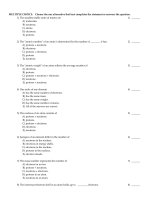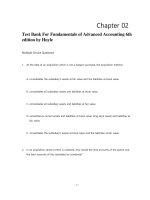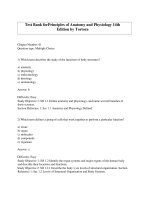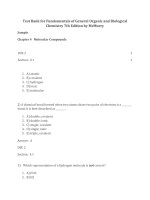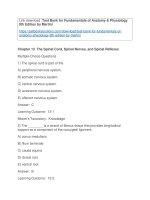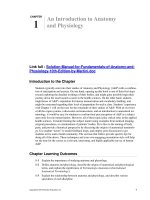Test bank for fundamentals of anatomy and physiology 11e c20
Bạn đang xem bản rút gọn của tài liệu. Xem và tải ngay bản đầy đủ của tài liệu tại đây (570.33 KB, 42 trang )
Chapterȱ20 TheȱHeart
Multiple Choice Questions
1) Theȱheartȱbeatsȱapproximatelyȱ________ȱtimesȱeachȱday.
A) 1,000
B) 10,000
C) 100,000
D) 1,000,000
E) 10,000,000
Answer: C
LearningȱOutcome: 20-1
BloomȇsȱTaxonomy: Remembering
2) Theȱheartȱpumpsȱapproximatelyȱ________ȱlitersȱofȱbloodȱeachȱday.
A) 8,000
B) 15,000
C) 20,000
D) 50,000
E) 100,000
Answer: A
LearningȱOutcome: 20-1
BloomȇsȱTaxonomy: Remembering
3) Theȱadultȱheartȱisȱroughlyȱtheȱsizeȱof
A) theȱliver.
B) aȱmanȇsȱclenchedȱfist.
C) theȱgallbladder.
D) theȱhandȱofȱaȱ10-year-old.
E) theȱbrain.
Answer: B
LearningȱOutcome: 20-1
BloomȇsȱTaxonomy: Remembering
4) Theȱtermȱusedȱtoȱdescribeȱfluidȱcollectingȱinȱtheȱpericardialȱcavityȱthatȱrestrictsȱtheȱmovement
ofȱtheȱheartȱisȱknownȱas
A) cardiacȱtamponade.
B) mitralȱvalveȱprolapse.
C) pleuralȱeffusion.
D) cardiomyopathy.
E) pericarditis.
Answer: A
LearningȱOutcome: 20-1
BloomȇsȱTaxonomy: Understanding
Copyrightȱ©ȱ2018ȱPearsonȱEducation,ȱInc.
654ȱȱȱTestȱBankȱforȱFundamentalsȱofȱAnatomyȱ&ȱPhysiology,ȱ11e
5) Theȱstructureȱthatȱpermitsȱbloodȱflowȱfromȱtheȱrightȱatriumȱtoȱtheȱleftȱatriumȱinȱtheȱfetal
circulationȱisȱthe
A) foramenȱovale.
B) interatrialȱseptum.
C) coronaryȱsinus.
D) fossaȱovalis.
E) ligamentumȱarteriosus.
Answer: A
LearningȱOutcome: 20-1
BloomȇsȱTaxonomy: Remembering
6) Bloodȱleavesȱtheȱrightȱventricleȱbyȱpassingȱthroughȱthe
A) aorticȱvalve.
B) pulmonaryȱvalve.
C) mitralȱvalve.
D) tricuspidȱvalve.
E) bicuspidȱvalve.
Answer: B
LearningȱOutcome: 20-1
BloomȇsȱTaxonomy: Remembering
7) Theȱatrioventricularȱvalvesȱpermitȱbloodȱflow
A) inȱoneȱdirectionȱonly.
B) inȱbothȱdirections.
C) inȱmanyȱdirections.
D) inȱoppositeȱdirectionsȱonȱtheȱrightȱandȱleft.
E) fromȱaȱventricleȱtoȱanȱatrium.
Answer: A
LearningȱOutcome: 20-1
BloomȇsȱTaxonomy: Remembering
8) Bloodȱreturningȱtoȱtheȱheartȱfromȱtheȱsystemicȱcircuitȱfirstȱentersȱthe
A) rightȱatrium.
B) rightȱventricle.
C) leftȱatrium.
D) leftȱventricle.
E) conusȱarteriosus.
Answer: A
LearningȱOutcome: 20-1
BloomȇsȱTaxonomy: Remembering
9) Bloodȱreturningȱtoȱtheȱheartȱfromȱtheȱpulmonaryȱcircuitȱfirstȱentersȱthe
A) rightȱatrium.
B) rightȱventricle.
C) leftȱatrium.
D) leftȱventricle.
E) conusȱarteriosus.
Answer: C
LearningȱOutcome: 20-1
BloomȇsȱTaxonomy: Remembering
Copyrightȱ©ȱ2018ȱPearsonȱEducation,ȱInc.
Chapterȱ20ȱȱTheȱHeartȱȱȱ655
10) Theȱearlikeȱextensionȱofȱtheȱatriumȱisȱthe
A) ventricle.
B) coronaryȱsinus.
C) coronaryȱsulcus.
D) auricle.
E) interatrialȱseptum.
Answer: D
LearningȱOutcome: 20-1
BloomȇsȱTaxonomy: Remembering
11) Theȱcoronaryȱsulcusȱisȱaȱgrooveȱthat
A) marksȱtheȱborderȱbetweenȱtheȱatriaȱandȱventricles.
B) marksȱtheȱboundaryȱlineȱbetweenȱtheȱrightȱandȱleftȱventricles.
C) marksȱtheȱboundaryȱlineȱbetweenȱtheȱrightȱandȱleftȱatria.
D) separatesȱtheȱatrioventricularȱvalvesȱfromȱtheȱatria.
E) separatesȱtheȱcoronaryȱarteriesȱfromȱtheȱcoronaryȱveins.
Answer: A
LearningȱOutcome: 20-1
BloomȇsȱTaxonomy: Remembering
12) Inȱtheȱmiddleȱofȱtheȱthoracicȱcavityȱisȱaȱregionȱoccupiedȱbyȱtheȱheart,ȱgreatȱvessels,ȱthymus,
esophagus,ȱandȱtracheaȱcalledȱthe
A) pleuralȱspace.
B) pericardialȱspace.
C) mediastinum.
D) cardiacȱnotch.
E) ventralȱcavity.
Answer: C
LearningȱOutcome: 20-1
BloomȇsȱTaxonomy: Remembering
13) Theȱcuspsȱ(leaflets)ȱofȱatrioventricularȱvalvesȱattachȱdirectlyȱto
A) papillaryȱmuscles.
B) trabeculaeȱcarneae.
C) chordaeȱtendineae.
D) interatrialȱsepta.
E) coronaryȱsulci.
Answer: C
LearningȱOutcome: 20-1
BloomȇsȱTaxonomy: Remembering
14) Contractionsȱofȱtheȱpapillaryȱmuscles
A) closeȱtheȱatrioventricularȱvalves.
B) closeȱtheȱsemilunarȱvalves.
C) ejectȱbloodȱfromȱtheȱventricles.
D) preventȱtheȱatrioventricularȱvalvesȱfromȱreversingȱintoȱtheȱatria.
E) ejectȱbloodȱfromȱtheȱatriaȱintoȱtheȱventricles.
Answer: D
LearningȱOutcome: 20-1
BloomȇsȱTaxonomy: Remembering
Copyrightȱ©ȱ2018ȱPearsonȱEducation,ȱInc.
656ȱȱȱTestȱBankȱforȱFundamentalsȱofȱAnatomyȱ&ȱPhysiology,ȱ11e
15) Theȱvisceralȱpericardiumȱisȱtheȱsameȱasȱthe
A) mediastinum.
B) parietalȱpericardium.
C) epicardium.
D) myocardium.
E) endocardium.
Answer: C
LearningȱOutcome: 20-1
BloomȇsȱTaxonomy: Remembering
16) Mostȱofȱtheȱmiddleȱlayerȱinȱtheȱheartȱwallȱisȱcomposedȱof
A) cardiacȱmuscleȱcells.
B) chondrocytes.
C) epithelialȱcells.
D) fibrocytes.
E) smoothȱmuscleȱcells.
Answer: A
LearningȱOutcome: 20-1
BloomȇsȱTaxonomy: Understanding
17) Theȱrightȱventricleȱpumpsȱbloodȱtoȱthe
A) rightȱandȱleftȱlungs.
B) leftȱventricle.
C) leftȱatrium.
D) aorta.
E) rightȱatrium.
Answer: A
LearningȱOutcome: 20-1
BloomȇsȱTaxonomy: Remembering
18) Theȱleftȱventricleȱpumpsȱbloodȱtoȱthe
A) lungs.
B) rightȱventricle.
C) rightȱatrium.
D) aorta.
E) pulmonaryȱcircuit.
Answer: D
LearningȱOutcome: 20-1
BloomȇsȱTaxonomy: Remembering
19) Theȱrightȱatriumȱreceivesȱbloodȱfromȱallȱofȱtheȱfollowingȱstructuresȱexceptȱthe
A) coronaryȱsinus.
B) superiorȱvenaȱcava.
C) inferiorȱvenaȱcava.
D) systemicȱcircuit.
E) pulmonaryȱveins.
Answer: E
LearningȱOutcome: 20-1
BloomȇsȱTaxonomy: Remembering
Copyrightȱ©ȱ2018ȱPearsonȱEducation,ȱInc.
Chapterȱ20ȱȱTheȱHeartȱȱȱ657
20) Whenȱaȱbloodȱclotȱformsȱonȱaȱrupturedȱplaqueȱinȱaȱcoronaryȱartery,ȱtheȱconditionȱisȱreferredȱto
asȱa(n)
A) coronaryȱspasm.
B) myocardialȱinfarction.
C) coronaryȱthrombosis.
D) anginaȱpectoris.
E) pulmonaryȱembolism.
Answer: C
LearningȱOutcome: 20-1
BloomȇsȱTaxonomy: Understanding
21) Cardiacȱcellsȱdamagedȱbyȱinfarctionȱwillȱshowȱallȱofȱtheȱfollowingȱexcept
A) aȱswitchȱtoȱanaerobicȱmetabolism.
B) releaseȱofȱenzymesȱintoȱtheȱcirculation.
C) releaseȱofȱtroponinȱTȱandȱIȱintoȱtheȱcirculation.
D) releaseȱofȱCK-MBȱintoȱtheȱcirculation.
E) anȱincreaseȱinȱmetabolicȱactivity.
Answer: E
LearningȱOutcome: 20-1
BloomȇsȱTaxonomy: Understanding
22) Asȱbloodȱleavesȱtheȱrightȱventricle,ȱitȱpassesȱthroughȱtheȱ________ȱandȱthenȱintoȱthe
pulmonaryȱtrunk.
A) pulmonaryȱveins
B) conusȱarteriosus
C) aorta
D) inferiorȱvenaȱcava
E) superiorȱvenaȱcava
Answer: B
LearningȱOutcome: 20-1
BloomȇsȱTaxonomy: Remembering
23) Coronaryȱveinsȱemptyȱintoȱthe
A) leftȱatrium.
B) leftȱventricle.
C) rightȱatrium.
D) rightȱventricle.
E) conusȱarteriosus.
Answer: C
LearningȱOutcome: 20-1
BloomȇsȱTaxonomy: Understanding
Copyrightȱ©ȱ2018ȱPearsonȱEducation,ȱInc.
658ȱȱȱTestȱBankȱforȱFundamentalsȱofȱAnatomyȱ&ȱPhysiology,ȱ11e
24) Thereȱareȱ________ȱpulmonaryȱveins.
A) 2
B) 4
C) 6
D) 8
E) 12
Answer: B
LearningȱOutcome: 20-1
BloomȇsȱTaxonomy: Remembering
25) Ruptureȱofȱtheȱpapillaryȱmusclesȱinȱtheȱleftȱventricleȱmayȱresultȱin
A) pulmonaryȱvalveȱregurgitation.
B) mitralȱvalveȱprolapse.
C) tricuspidȱregurgitation.
D) tricuspidȱprolapse.
E) aorticȱvalveȱprolapse.
Answer: B
LearningȱOutcome: 20-1
BloomȇsȱTaxonomy: Understanding
26) Bloodȱisȱsuppliedȱtoȱtheȱmuscularȱwallȱofȱtheȱleftȱatriumȱbyȱthe
A) brachiocephalicȱartery.
B) rightȱcoronaryȱartery.
C) leftȱcoronaryȱartery.
D) phrenicȱarteries.
E) pulmonaryȱarteries.
Answer: C
LearningȱOutcome: 20-1
BloomȇsȱTaxonomy: Remembering
27) Theȱpulmonaryȱvalveȱpreventsȱbackwardȱflowȱintoȱthe
A) aorta.
B) pulmonaryȱtrunk.
C) pulmonaryȱveins.
D) rightȱventricle.
E) leftȱatrium.
Answer: D
LearningȱOutcome: 20-1
BloomȇsȱTaxonomy: Remembering
28) Theȱbicuspidȱorȱmitralȱvalveȱisȱlocated
A) inȱtheȱopeningȱofȱtheȱaorta.
B) inȱtheȱopeningȱofȱtheȱpulmonaryȱtrunk.
C) whereȱtheȱvenaeȱcavaeȱjoinȱtheȱrightȱatrium.
D) betweenȱtheȱrightȱatriumȱandȱrightȱventricle.
E) betweenȱtheȱleftȱatriumȱandȱleftȱventricle.
Answer: E
LearningȱOutcome: 20-1
BloomȇsȱTaxonomy: Remembering
Copyrightȱ©ȱ2018ȱPearsonȱEducation,ȱInc.
Chapterȱ20ȱȱTheȱHeartȱȱȱ659
29) Theȱ________ȱvalveȱpreventsȱbackwardȱflowȱintoȱtheȱleftȱatrium.
A) semicaval
B) semilunar
C) bicuspid
D) tricuspid
E) pulmonic
Answer: C
LearningȱOutcome: 20-1
BloomȇsȱTaxonomy: Remembering
30) Theȱfunctionȱofȱanȱatriumȱisȱto
A) storeȱbloodȱforȱuseȱbyȱtheȱmyocardialȱcells.
B) pumpȱbloodȱtoȱtheȱlungs.
C) pumpȱbloodȱintoȱtheȱsystemicȱcircuit.
D) pumpȱbloodȱtoȱtheȱventricle.
E) collectȱbloodȱthenȱpumpȱitȱtoȱtheȱventricle.
Answer: E
LearningȱOutcome: 20-1
BloomȇsȱTaxonomy: Remembering
31) Comparedȱtoȱtheȱrightȱventricle,ȱtheȱleftȱventricleȱhasȱallȱtheȱfollowingȱcharacteristicsȱ except
A) hasȱaȱthickerȱwall.
B) isȱroundȱinȱcrossȱsection.
C) pumpsȱaȱgreaterȱvolume.
D) worksȱharder.
E) producesȱaboutȱfourȱtoȱsixȱtimesȱmoreȱpressureȱwhenȱitȱcontracts.
Answer: C
LearningȱOutcome: 20-1
BloomȇsȱTaxonomy: Remembering
32) Whichȱofȱtheȱfollowingȱareȱinvolvedȱinȱtheȱpulmonaryȱcircuit?
A) superiorȱvenaȱcava,ȱrightȱatrium,ȱleftȱventricle
B) rightȱventricle,ȱpulmonaryȱveins,ȱaorta
C) rightȱventricle,ȱpulmonaryȱtrunk,ȱleftȱatrium
D) inferiorȱvenaȱcava,ȱrightȱatrium,ȱaorta
E) leftȱventricle,ȱpulmonaryȱveins,ȱrightȱatrium
Answer: C
LearningȱOutcome: 20-1
BloomȇsȱTaxonomy: Remembering
33) Theȱrightȱpulmonaryȱveinsȱcarryȱ________ȱbloodȱtoȱtheȱ________.
A) deoxygenated;ȱleftȱatrium
B) oxygenated;ȱrightȱlung
C) deoxygenated;ȱsuperiorȱvenaȱcava
D) deoxygenated;ȱrightȱatrium
E) oxygenated;ȱleftȱatrium
Answer: E
LearningȱOutcome: 20-1
BloomȇsȱTaxonomy: Understanding
Copyrightȱ©ȱ2018ȱPearsonȱEducation,ȱInc.
660ȱȱȱTestȱBankȱforȱFundamentalsȱofȱAnatomyȱ&ȱPhysiology,ȱ11e
34) Theȱfollowingȱisȱaȱlistȱofȱvesselsȱandȱstructuresȱthatȱareȱassociatedȱwithȱtheȱheart.ȱWhatȱisȱthe
correctȱorderȱforȱtheȱflowȱofȱbloodȱenteringȱfromȱtheȱsystemicȱcirculation?ȱ
1.ȱrightȱatrium
2.ȱleftȱatrium
3.ȱrightȱventricle
4.ȱleftȱventricle
5.ȱvenaeȱcavae
6.ȱaorta
7.ȱpulmonaryȱtrunk
8.ȱpulmonaryȱveins
A) 1,ȱ2,ȱ7,ȱ8,ȱ3,ȱ4,ȱ6,ȱ5
B) 1,ȱ7,ȱ3,ȱ8,ȱ2,ȱ4,ȱ6,ȱ5
C) 5,ȱ1,ȱ3,ȱ7,ȱ8,ȱ2,ȱ4,ȱ6
D) 5,ȱ3,ȱ1,ȱ7,ȱ8,ȱ4,ȱ2,ȱ6
E) 5,ȱ1,ȱ3,ȱ8,ȱ7,ȱ2,ȱ4,ȱ6
Answer: C
LearningȱOutcome: 20-1
BloomȇsȱTaxonomy: Remembering
35) Theȱpulmonaryȱarteriesȱcarryȱbloodȱtoȱthe
A) heart.
B) lungs.
C) brain.
D) intestines.
E) liver.
Answer: B
LearningȱOutcome: 20-1
BloomȇsȱTaxonomy: Remembering
36) Theȱpulmonaryȱveinsȱcarryȱbloodȱtoȱthe
A) heart.
B) lungs.
C) brain.
D) intestines.
E) liver.
Answer: A
LearningȱOutcome: 20-1
BloomȇsȱTaxonomy: Remembering
37) Theȱforamenȱovaleȱinȱtheȱfetalȱheartȱisȱlocatedȱinȱthe
A) rightȱatrium.
B) leftȱatrium.
C) rightȱventricle.
D) leftȱventricle.
E) interatrialȱseptum.
Answer: E
LearningȱOutcome: 20-1
BloomȇsȱTaxonomy: Understanding
Copyrightȱ©ȱ2018ȱPearsonȱEducation,ȱInc.
Chapterȱ20ȱȱTheȱHeartȱȱȱ661
38) Bloodȱisȱsuppliedȱtoȱtheȱmyocardiumȱby
A) theȱcoronaryȱsinus.
B) contactȱwithȱbloodȱinȱtheȱpumpingȱchambers.
C) theȱcoronaryȱarteries.
D) arteriesȱthatȱbranchȱfromȱtheȱpulmonaryȱarteries.
E) arteriesȱthatȱbranchȱoffȱtheȱsubclavianȱarteries.
Answer: C
LearningȱOutcome: 20-1
BloomȇsȱTaxonomy: Remembering
39) Theȱfirstȱbloodȱvesselsȱtoȱbranchȱfromȱtheȱaortaȱareȱtheȱ________ȱarteries.
A) pulmonary
B) coronary
C) circumflex
D) carotid
E) subclavian
Answer: B
LearningȱOutcome: 20-1
BloomȇsȱTaxonomy: Remembering
40) Theȱmarginalȱbranchȱandȱposteriorȱinterventricularȱbranchȱareȱbranchesȱofȱthe
A) rightȱcoronaryȱartery.
B) leftȱcoronaryȱartery.
C) circumflexȱartery.
D) coronaryȱsinus.
E) aorta.
Answer: A
LearningȱOutcome: 20-1
BloomȇsȱTaxonomy: Remembering
41) Theȱcircumflexȱbranchȱandȱtheȱanteriorȱinterventricularȱarteryȱareȱbranchesȱofȱthe
A) rightȱcoronaryȱartery.
B) leftȱcoronaryȱartery.
C) interventricularȱartery.
D) coronaryȱsinus.
E) aorta.
Answer: B
LearningȱOutcome: 20-1
BloomȇsȱTaxonomy: Remembering
42) Theȱgreatȱandȱmiddleȱcardiacȱveinsȱdrainȱbloodȱintoȱthe
A) superiorȱvenaȱcava.
B) inferiorȱvenaȱcava.
C) coronaryȱsinus.
D) coronaryȱsulcus.
E) aorta.
Answer: C
LearningȱOutcome: 20-1
BloomȇsȱTaxonomy: Remembering
Copyrightȱ©ȱ2018ȱPearsonȱEducation,ȱInc.
662ȱȱȱTestȱBankȱforȱFundamentalsȱofȱAnatomyȱ&ȱPhysiology,ȱ11e
43) Theȱheartȱliesȱwithinȱtheȱ________ȱcavity.
A) peritoneal
B) pleural
C) orbital
D) dorsal
E) pericardial
Answer: E
LearningȱOutcome: 20-1
BloomȇsȱTaxonomy: Remembering
44) Theȱsuperiorȱportionȱofȱtheȱheartȱwhereȱmajorȱbloodȱvesselsȱenterȱandȱexitȱisȱthe
A) apex.
B) hilum.
C) base.
D) septum.
E) mediastinum.
Answer: C
LearningȱOutcome: 20-1
BloomȇsȱTaxonomy: Remembering
45) Theȱinferiorȱpointȱofȱtheȱheartȱisȱcalledȱthe
A) apex.
B) hilum.
C) base.
D) septum.
E) mediastinum.
Answer: A
LearningȱOutcome: 20-1
BloomȇsȱTaxonomy: Remembering
46) Pericardialȱfluid
A) providesȱoxygenȱtoȱtheȱheartȱmuscle.
B) isȱlocatedȱbetweenȱtheȱmyocardiumȱandȱtheȱendocardium.
C) isȱaȱlubricantȱbetweenȱtheȱheartȱandȱtheȱpericardialȱsac.
D) consistsȱofȱplasmaȱthatȱhasȱleakedȱoutȱofȱwholeȱblood.
E) flowsȱthroughȱtheȱfourȱchambersȱofȱtheȱheart.
Answer: C
LearningȱOutcome: 20-1
BloomȇsȱTaxonomy: Remembering
47) Theȱ________ȱisȱsharedȱbyȱtheȱtwoȱventricles.
A) venaȱcava
B) bicuspidȱvalve
C) chordaeȱtendineae
D) interventricularȱseptum
E) trabeculaeȱcarneae
Answer: D
LearningȱOutcome: 20-1
BloomȇsȱTaxonomy: Remembering
Copyrightȱ©ȱ2018ȱPearsonȱEducation,ȱInc.
Chapterȱ20ȱȱTheȱHeartȱȱȱ663
48) Muscularȱridgesȱonȱtheȱinnerȱsurfaceȱofȱtheȱventriclesȱareȱcalled
A) coronaryȱsinuses.
B) trabeculaeȱcarneae.
C) intercalatedȱdiscs.
D) papillaryȱmuscles.
E) chordaeȱtendineae.
Answer: B
LearningȱOutcome: 20-1
BloomȇsȱTaxonomy: Remembering
49) Theȱ________ȱcircuitȱcarriesȱbloodȱtoȱandȱfromȱtheȱlungs.
A) pulmonary
B) systemic
C) oxygen
D) portal
E) primary
Answer: A
LearningȱOutcome: 20-1
BloomȇsȱTaxonomy: Remembering
50) Theȱ________ȱcircuitȱcarriesȱbloodȱfromȱtheȱaortaȱtoȱtheȱrightȱventricle.
A) pulmonary
B) systemic
C) oxygen
D) portal
E) primary
Answer: B
LearningȱOutcome: 20-1
BloomȇsȱTaxonomy: Remembering
51) Theȱ________ȱcarryȱbloodȱawayȱfromȱtheȱheart.
A) arterioles
B) arteries
C) veins
D) venules
E) capillaries
Answer: B
LearningȱOutcome: 20-1
BloomȇsȱTaxonomy: Remembering
52) Theȱ________ȱcarryȱbloodȱtowardȱtheȱheart.
A) arterioles
B) arteries
C) veins
D) lacteals
E) capillaries
Answer: C
LearningȱOutcome: 20-1
BloomȇsȱTaxonomy: Remembering
Copyrightȱ©ȱ2018ȱPearsonȱEducation,ȱInc.
664ȱȱȱTestȱBankȱforȱFundamentalsȱofȱAnatomyȱ&ȱPhysiology,ȱ11e
53) Theȱ________ȱcoversȱtheȱouterȱsurfaceȱofȱtheȱheart.
A) epicardium
B) myocardium
C) endocardium
D) parietalȱpericardium
E) mediastinum
Answer: A
LearningȱOutcome: 20-1
BloomȇsȱTaxonomy: Remembering
54) Theȱmuscleȱlayerȱofȱtheȱheartȱisȱthe
A) epicardium.
B) myocardium.
C) endocardium.
D) parietalȱpericardium.
E) mediastinum.
Answer: B
LearningȱOutcome: 20-1
BloomȇsȱTaxonomy: Remembering
55) Theȱ________ȱlinesȱtheȱchambersȱofȱtheȱheart,ȱcoversȱtheȱheartȱvalves,ȱandȱisȱcontinuousȱwith
theȱendothelium.
A) epicardium
B) myocardium
C) endocardium
D) visceralȱpericardium
E) mediastinum
Answer: C
LearningȱOutcome: 20-1
BloomȇsȱTaxonomy: Remembering
56) Oxygenȱisȱaddedȱtoȱbloodȱasȱitȱflowsȱthroughȱtheȱ________ȱcircuit.
A) pulmonary
B) systemic
C) oxygen
D) portal
E) primary
Answer: A
LearningȱOutcome: 20-1
BloomȇsȱTaxonomy: Remembering
57) Theȱtermȱ________ȱrefersȱtoȱblockageȱinȱtheȱcoronaryȱcirculation.
A) congestiveȱheartȱfailure
B) atherosclerosis
C) coronaryȱarteryȱdisease
D) embolism
E) phlebitis
Answer: C
LearningȱOutcome: 20-1
BloomȇsȱTaxonomy: Understanding
Copyrightȱ©ȱ2018ȱPearsonȱEducation,ȱInc.
Chapterȱ20ȱȱTheȱHeartȱȱȱ665
58) ________ȱisȱtheȱsymptomȱgenerallyȱbroughtȱonȱbyȱcoronaryȱischemia.
A) Anginaȱpectoris
B) Memoryȱloss
C) Aȱrash
D) Hematuria
E) Fluidȱinȱtheȱlungs
Answer: A
LearningȱOutcome: 20-1
BloomȇsȱTaxonomy: Understanding
59) Inȱaȱprocedureȱknownȱasȱ________,ȱanȱinflatableȱballoonȱatȱtheȱendȱofȱaȱcatheterȱisȱusedȱto
pressȱplaqueȱbackȱagainstȱtheȱvesselȱwall.
A) balloonȱangioplasty
B) coronaryȱarterialȱbypassȱgraft
C) intravenousȱcatheterization
D) ablation
E) atherectomy
Answer: A
LearningȱOutcome: 20-1
BloomȇsȱTaxonomy: Understanding
60) Aȱprocedureȱinȱwhichȱaȱlengthȱofȱtheȱpatientȇsȱveinȱorȱarteryȱisȱusedȱtoȱcreateȱaȱdetourȱaround
anȱobstructionȱinȱaȱcoronaryȱarteryȱisȱcalled
A) balloonȱangioplasty.
B) coronaryȱarteryȱbypassȱgraft.
C) intravenousȱcatheterization.
D) ablation.
E) atherectomy.
Answer: B
LearningȱOutcome: 20-1
BloomȇsȱTaxonomy: Understanding
61) Aȱfineȱtubularȱwireȱmeshȱcalledȱaȱ________ȱmayȱbeȱinsertedȱintoȱaȱcoronaryȱvessel,ȱholdingȱit
open.
A) angioplast
B) stent
C) angiogram
D) keyhole
E) catheter
Answer: B
LearningȱOutcome: 20-1
BloomȇsȱTaxonomy: Remembering
Copyrightȱ©ȱ2018ȱPearsonȱEducation,ȱInc.
666ȱȱȱTestȱBankȱforȱFundamentalsȱofȱAnatomyȱ&ȱPhysiology,ȱ11e
62) Theȱcoronaryȱsinusȱdrainsȱtheȱ________ȱintoȱtheȱ________.
A) coronaryȱarteries;ȱleftȱventricle
B) cardiacȱveins;ȱrightȱatrium
C) interventricularȱartery;ȱleftȱventricle
D) rightȱatrium;ȱrightȱventricle
E) cardiacȱvein;ȱrightȱventricle
Answer: B
LearningȱOutcome: 20-1
BloomȇsȱTaxonomy: Remembering
63) Theȱ________ȱisȱaȱremnantȱofȱanȱimportantȱfetalȱbloodȱvesselȱthatȱonceȱlinkedȱtheȱpulmonary
andȱsystemicȱcircuits.
A) fossaȱovalis
B) ductusȱarteriosus
C) foramenȱovale
D) ductusȱvenosus
E) ligamentumȱarteriosum
Answer: E
LearningȱOutcome: 20-1
BloomȇsȱTaxonomy: Understanding
64) Whichȱofȱtheȱfollowingȱstatementsȱisȱtrue concerningȱdifferencesȱbetweenȱtheȱrightȱandȱleft
ventricles?
A) Theȱrightȱventricleȱpumpsȱwithȱmoreȱforceȱcomparedȱtoȱtheȱleft.
B) Theȱleftȱventriclesȱpumpsȱtwiceȱasȱmuchȱbloodȱasȱtheȱrightȱventricle.
C) Theȱrightȱventriclesȱpumpsȱbloodȱtoȱtheȱbody,ȱwhereasȱtheȱleftȱventricleȱpumpsȱbloodȱto
theȱlungs.
D) Theȱrightȱventricleȱisȱconical-shapedȱwhileȱtheȱleftȱventricleȱisȱhalf-moonȱshaped.
E) Theȱefficiencyȱofȱtheȱrightȱventricleȱisȱincreasedȱbyȱtheȱleftȱventricleȱbecauseȱtheȱwallȱof
theȱleftȱventricleȱpushesȱintoȱtheȱrightȱventricle.
Answer: E
LearningȱOutcome: 20-1
BloomȇsȱTaxonomy: Understanding
65) Cardiacȱmuscleȱlayersȱformȱthisȱdistinctȱpattern.
A) innerȱlongitudinalȱlayer
B) outerȱlongitudinalȱlayer
C) outerȱcircularȱlayer
D) figureȱeight
E) weave
Answer: D
LearningȱOutcome: 20-1
BloomȇsȱTaxonomy: Remembering
Copyrightȱ©ȱ2018ȱPearsonȱEducation,ȱInc.
Chapterȱ20ȱȱTheȱHeartȱȱȱ667
66) Theȱendocardiumȱconsistsȱofȱthisȱtypeȱofȱtissue.
A) cardiacȱmuscle
B) simpleȱsquamousȱepithelium
C) denseȱirregularȱconnectiveȱtissue
D) reticularȱconnectiveȱtissue
E) stratifiedȱsquamousȱepithelium
Answer: B
LearningȱOutcome: 20-1
BloomȇsȱTaxonomy: Remembering
67) Aȱholeȱinȱtheȱinterventricularȱseptumȱinȱanȱinfantȱmayȱcauseȱallȱofȱtheȱfollowingȱsymptoms
except
A) mixingȱofȱoxygen-richȱandȱoxygen-poorȱblood.
B) aȱmurmurȱtoȱbeȱheard.
C) theȱheartȱtoȱworkȱharder.
D) theȱindividualȱtoȱhaveȱlowȱperipheralȱoxygenȱsaturation.
E) build-upȱofȱatheroscleroticȱplaque.
Answer: E
LearningȱOutcome: 20-1
BloomȇsȱTaxonomy: Applying
68) Thickȱprojectionsȱofȱmuscleȱinȱtheȱventriclesȱthatȱanchorȱchordaeȱtendineaeȱareȱcalled
A) pectinateȱmuscles.
B) conusȱarteriosus.
C) papillaryȱmuscles.
D) trabeculaeȱcarneae.
E) auricles.
Answer: C
LearningȱOutcome: 20-1
BloomȇsȱTaxonomy: Remembering
69) Prominentȱmuscularȱridgesȱinȱtheȱanteriorȱatrialȱwallȱandȱauriclesȱareȱcalled
A) pectinateȱmuscles.
B) conusȱarteriosus.
C) papillaryȱmuscles.
D) trabeculaeȱcarneae.
E) fossaȱovalis.
Answer: A
LearningȱOutcome: 20-1
BloomȇsȱTaxonomy: Remembering
70) Whichȱofȱtheȱfollowingȱisȱnotȱtrueȱregardingȱtheȱrightȱatrioventricularȱvalve?
A) Itȱhasȱ3ȱcusps.
B) Itȱisȱalsoȱcalledȱtheȱtricuspidȱvalve.
C) Itȱpreventsȱbackflowȱofȱbloodȱfromȱtheȱrightȱventricleȱintoȱtheȱrightȱatrium.
D) Theȱvalveȱclosesȱwhenȱtheȱrightȱatriumȱcontracts.
E) Theȱcuspsȱprovideȱone-wayȱflowȱofȱblood.
Answer: D
LearningȱOutcome: 20-1
BloomȇsȱTaxonomy: Understanding
Copyrightȱ©ȱ2018ȱPearsonȱEducation,ȱInc.
668ȱȱȱTestȱBankȱforȱFundamentalsȱofȱAnatomyȱ&ȱPhysiology,ȱ11e
71) Theȱ________ȱisȱanȱimportantȱridgeȱofȱmuscleȱextendingȱhorizontallyȱaroundȱtheȱrightȱventricle
fromȱtheȱinterventricularȱseptumȱtoȱtheȱbaseȱofȱtheȱanteriorȱpapillaryȱmuscleȱcontainingȱpartȱof
theȱconductingȱsystem.
A) auricle
B) pectinateȱmuscle
C) trabeculaeȱcarneae
D) moderatorȱband
E) conusȱarteriosus
Answer: D
LearningȱOutcome: 20-1
BloomȇsȱTaxonomy: Remembering
72) Whichȱvalve(s)ȱcontainsȱ2ȱcusps?
A) rightȱAVȱvalve
B) leftȱAVȱvalve
C) rightȱandȱleftȱAVȱvalves
D) leftȱAVȱandȱaorticȱvalves
E) rightȱAVȱandȱpulmonaryȱvalves
Answer: B
LearningȱOutcome: 20-1
BloomȇsȱTaxonomy: Remembering
73) Whichȱvalve(s)ȱcuspsȱopenȱupȱtowardȱtheȱbaseȱofȱtheȱheart?
A) rightȱandȱleftȱAVȱvalves
B) aorticȱandȱpulmonaryȱvalves
C) leftȱAVȱandȱaorticȱvalves
D) rightȱAVȱandȱpulmonaryȱvalves
E) rightȱAV,ȱleftȱAV,ȱaorticȱandȱpulmonaryȱvalves
Answer: B
LearningȱOutcome: 20-1
BloomȇsȱTaxonomy: Understanding
74) Theseȱstructuresȱkeepȱtheȱaorticȱvalveȱcuspsȱfromȱstickingȱtoȱtheȱwallȱofȱtheȱaorta.
A) auricles
B) chordaeȱtendineae
C) papillaryȱmuscles
D) pectinateȱmuscles
E) aorticȱsinuses
Answer: E
LearningȱOutcome: 20-1
BloomȇsȱTaxonomy: Remembering
Copyrightȱ©ȱ2018ȱPearsonȱEducation,ȱInc.
Chapterȱ20ȱȱTheȱHeartȱȱȱ669
75) Whichȱstatementȱcorrectlyȱdescribesȱtheȱtermȱleftȱatrioventricularȱvalve?
A) Itsȱcuspsȱopenȱintoȱtheȱleftȱatrium.
B) Itsȱcuspsȱopenȱintoȱtheȱsuperiorȱvenaȱcava.
C) Itsȱcuspsȱopenȱintoȱtheȱaorta.
D) Itsȱcuspsȱopenȱintoȱtheȱleftȱventricle.
E) Itsȱcuspsȱopenȱintoȱtheȱpulmonaryȱtrunk.
Answer: D
LearningȱOutcome: 20-1
BloomȇsȱTaxonomy: Understanding
76) Whichȱchamberȱhasȱtheȱthickestȱwall?
A) leftȱatrium
B) rightȱatrium
C) leftȱventricle
D) rightȱventricle
E) leftȱauricle
Answer: C
LearningȱOutcome: 20-1
BloomȇsȱTaxonomy: Remembering
77) AnȱMIȱthatȱaffectsȱtheȱ________ȱsideȱofȱtheȱheartȱisȱmoreȱsevereȱbecauseȱitȱhasȱtoȱpumpȱblood
withȱ________ȱforce.
A) right;ȱless
B) right;ȱmore
C) left;ȱless
D) left;ȱmore
E) right;ȱequal
Answer: D
LearningȱOutcome: 20-1
BloomȇsȱTaxonomy: Understanding
78) Oneȱpossibleȱconsequenceȱofȱuntreatedȱstrepȱthroatȱisȱaȱdiseaseȱcausingȱinflammationȱofȱheart
called
A) rheumaticȱfever.
B) rheumatoidȱarthritis.
C) coronaryȱthrombosis.
D) coronaryȱischemia.
E) anginaȱpectoris.
Answer: A
LearningȱOutcome: 20-1
BloomȇsȱTaxonomy: Understanding
Copyrightȱ©ȱ2018ȱPearsonȱEducation,ȱInc.
670ȱȱȱTestȱBankȱforȱFundamentalsȱofȱAnatomyȱ&ȱPhysiology,ȱ11e
79) Rheumaticȱfeverȱcausesȱgeneralizedȱinflammationȱofȱtheȱheartȱcalled
A) rheumatoidȱarthritis.
B) coronaryȱthrombosis.
C) carditis.
D) coronaryȱischemia.
E) myocardialȱinfarction.
Answer: C
LearningȱOutcome: 20-1
BloomȇsȱTaxonomy: Remembering
80) Theȱconnectiveȱtissuesȱofȱtheȱheartȱareȱimportantȱforȱallȱofȱtheȱfollowingȱreasonsȱ except
A) theyȱhelpȱdistributeȱtheȱforcesȱofȱcontraction.
B) theyȱpreventȱoverexpansionȱofȱtheȱheart.
C) theyȱprovideȱsupportȱforȱbloodȱvesselsȱandȱnerves.
D) theyȱproduceȱtheȱpericardialȱfluid.
E) theyȱprovideȱelasticityȱtoȱhelpȱtheȱheartȱreturnȱtoȱitsȱoriginalȱshapeȱafterȱcontraction.
Answer: D
LearningȱOutcome: 20-1
BloomȇsȱTaxonomy: Understanding
Copyrightȱ©ȱ2018ȱPearsonȱEducation,ȱInc.
Chapterȱ20ȱȱTheȱHeartȱȱȱ671
Figureȱ20-1ȱTheȱHeart
UseȱFigureȱ20-1ȱtoȱanswerȱtheȱfollowingȱquestions:
81) IdentifyȱtheȱstructureȱlabeledȱȈ19.Ȉ
A) tricuspidȱvalve
B) pulmonaryȱsemilunarȱvalve
C) aorticȱsemilunarȱvalve
D) bicuspidȱvalve
E) ligamentumȱarteriosum
Answer: B
LearningȱOutcome: 20-1
BloomȇsȱTaxonomy: Understanding
Copyrightȱ©ȱ2018ȱPearsonȱEducation,ȱInc.
672ȱȱȱTestȱBankȱforȱFundamentalsȱofȱAnatomyȱ&ȱPhysiology,ȱ11e
82) Identifyȱtheȱstructure(s)ȱlabeledȱȈ8.Ȉ
A) moderatorȱband
B) pectinateȱmuscles
C) papillaryȱmuscles
D) trabeculaeȱcarneae
E) chordaeȱtendineae
Answer: C
LearningȱOutcome: 20-1
BloomȇsȱTaxonomy: Understanding
83) IdentifyȱtheȱstructureȱlabeledȱȈ6.Ȉ
A) cuspȱofȱtricuspidȱvalve
B) pulmonaryȱsemilunarȱvalve
C) aorticȱsemilunarȱvalve
D) bicuspidȱvalve
E) ligamentumȱarteriosum
Answer: A
LearningȱOutcome: 20-1
BloomȇsȱTaxonomy: Understanding
84) Whichȱchamberȱreceivesȱoxygenatedȱbloodȱfromȱtheȱpulmonaryȱcircuit?
A) 5
B) 10
C) 16
D) 13
E) bothȱ5ȱandȱ16
Answer: C
LearningȱOutcome: 20-1
BloomȇsȱTaxonomy: Understanding
85) IdentifyȱtheȱstructureȱlabeledȱȈ22.Ȉ
A) pulmonaryȱtrunk
B) aorticȱarch
C) pulmonaryȱveins
D) superiorȱvenaȱcava
E) carotidȱartery
Answer: B
LearningȱOutcome: 20-1
BloomȇsȱTaxonomy: Understanding
86) Tetanicȱmuscleȱcontractionsȱdonȇtȱoccurȱinȱaȱnormalȱcardiacȱmuscleȱbecause
A) cardiacȱmuscleȱtissueȱcontractsȱonȱitsȱown.
B) neuralȱstimulationȱisȱlacking.
C) theȱrefractoryȱperiodȱlastsȱuntilȱtheȱmuscleȱrelaxes.
D) theȱrefractoryȱperiodȱendsȱbeforeȱtheȱmuscleȱreachesȱpeakȱtension.
E) potassiumȱchannelsȱoutnumberȱsodiumȱchannels.
Answer: C
LearningȱOutcome: 20-2
BloomȇsȱTaxonomy: Understanding
Copyrightȱ©ȱ2018ȱPearsonȱEducation,ȱInc.
Chapterȱ20ȱȱTheȱHeartȱȱȱ673
87) Cardiacȱmuscleȱcellsȱandȱskeletalȱmuscleȱcellsȱdifferȱinȱaȱfewȱways.ȱWhichȱofȱtheȱfollowingȱis
notȱoneȱofȱthem?
A) Cardiacȱmuscleȱcellsȱareȱsmallerȱinȱsize.
B) Cardiacȱmuscleȱcellsȱhaveȱaȱsingle,ȱcenteredȱnucleus.
C) Cardiacȱmuscleȱcellsȱbranch.
D) Skeletalȱmuscleȱcellsȱlackȱintercalatedȱdiscs.
E) Cardiacȱmuscleȱcellsȱlackȱtransverseȱtubules.
Answer: E
LearningȱOutcome: 20-2
BloomȇsȱTaxonomy: Understanding
88) Inȱcardiacȱmuscle,ȱtheȱfastȱdepolarizationȱphaseȱofȱtheȱactionȱpotentialȱisȱtheȱresultȱof
A) increasedȱmembraneȱpermeabilityȱtoȱsodiumȱions.
B) increasedȱmembraneȱpermeabilityȱtoȱpotassiumȱions.
C) decreasedȱmembraneȱpermeabilityȱtoȱcalciumȱions.
D) decreasedȱmembraneȱpermeabilityȱtoȱsodiumȱions.
E) increasedȱmembraneȱpermeabilityȱtoȱchlorideȱions.
Answer: A
LearningȱOutcome: 20-2
BloomȇsȱTaxonomy: Remembering
89) Theȱlongȱplateauȱphaseȱofȱtheȱcardiacȱmuscleȱactionȱpotentialȱisȱdueȱto
A) movementȱofȱfewerȱsodiumȱionsȱacrossȱtheȱcellȱmembrane.
B) calciumȱchannelsȱremainingȱopen.
C) increasedȱmembraneȱpermeabilityȱtoȱpotassiumȱion.
D) decreaseȱinȱtheȱamountȱofȱcalciumȱdiffusingȱacrossȱtheȱmembrane.
E) increasedȱmembraneȱpermeabilityȱtoȱsodiumȱions.
Answer: B
LearningȱOutcome: 20-2
BloomȇsȱTaxonomy: Remembering
90) Inȱcardiacȱmuscle,
A) calciumȱionsȱareȱnotȱreleasedȱfromȱtheȱsarcoplasmicȱreticulum.
B) calciumȱionsȱdoȱnotȱbindȱtoȱtroponinȱmolecules.
C) calciumȱionsȱplayȱnoȱroleȱinȱtheȱprocessȱofȱcontraction.
D) aboutȱ20ȱpercentȱofȱtheȱcalciumȱionȱrequiredȱforȱcontractionȱcomesȱfromȱoutsideȱtheȱcell.
E) calciumȱionsȱplayȱanȱimportantȱroleȱinȱrepolarizingȱtheȱmembraneȱafterȱthe
depolarizationȱphase.
Answer: D
LearningȱOutcome: 20-2
BloomȇsȱTaxonomy: Remembering
Copyrightȱ©ȱ2018ȱPearsonȱEducation,ȱInc.
674ȱȱȱTestȱBankȱforȱFundamentalsȱofȱAnatomyȱ&ȱPhysiology,ȱ11e
91) Theȱnormalȱpacemakerȱofȱtheȱheartȱisȱlocatedȱin
A) theȱPurkinjeȱfibers.
B) theȱsinoatrialȱnode.
C) theȱatrioventricularȱnode.
D) theȱwallȱofȱtheȱleftȱventricle.
E) bothȱtheȱleftȱandȱrightȱventricles.
Answer: B
LearningȱOutcome: 20-2
BloomȇsȱTaxonomy: Remembering
92) Abnormallyȱslowȱdepolarizationȱofȱtheȱventriclesȱwouldȱmostȱchangeȱtheȱshapeȱofȱthe
________ȱinȱanȱECGȱtracing.
A) Pȱwave
B) Tȱwave
C) QRSȱcomplex
D) P-Rȱinterval
E) R-Tȱinterval
Answer: C
LearningȱOutcome: 20-2
BloomȇsȱTaxonomy: Understanding
93) Asȱaȱresultȱofȱtheȱlongȱrefractoryȱperiodȱinȱtheȱcardiacȱactionȱpotential,ȱcardiacȱmuscleȱcannot
exhibit
A) tonus.
B) treppe.
C) tetany.
D) recruitment.
E) fatigue.
Answer: C
LearningȱOutcome: 20-2
BloomȇsȱTaxonomy: Understanding
94) IfȱtheȱpacemakerȱcellsȱinȱtheȱSAȱnodeȱbecomeȱmoreȱpermeableȱtoȱpotassiumȱions,ȱthe
A) heartȱrateȱwillȱincrease.
B) heartȱrateȱwillȱdecrease.
C) cellsȱwillȱdepolarize.
D) cellsȱwillȱhyperpolarize.
E) heartȱrateȱwillȱdecreaseȱandȱcellsȱwillȱhyperpolarize.
Answer: E
LearningȱOutcome: 20-2
BloomȇsȱTaxonomy: Applying
Copyrightȱ©ȱ2018ȱPearsonȱEducation,ȱInc.
Chapterȱ20ȱȱTheȱHeartȱȱȱ675
95) IfȱtheȱconnectionȱbetweenȱtheȱSAȱnodeȱandȱAVȱnodeȱbecomesȱblocked,
A) theȱventriclesȱwillȱbeatȱfaster.
B) theȱventriclesȱwillȱbeatȱmoreȱslowly.
C) theȱventricularȱbeatȱwillȱremainȱunchanged.
D) cardiacȱoutputȱwillȱincrease.
E) theȱatriaȱwillȱcontractȱmoreȱforcefully.
Answer: B
LearningȱOutcome: 20-2
BloomȇsȱTaxonomy: Applying
96) Theȱfollowingȱareȱstructuralȱcomponentsȱofȱtheȱconductingȱsystemȱofȱtheȱheart.
1.ȱPurkinjeȱfibers
2.ȱAVȱbundle
3.ȱAVȱnode
4.ȱSAȱnode
5.ȱbundleȱbranches
Theȱsequenceȱinȱwhichȱexcitationȱwouldȱmoveȱthroughȱthisȱsystemȱis
A) 1,ȱ4,ȱ3,ȱ2,ȱ5.
B) 3,ȱ2,ȱ4,ȱ5,ȱ1.
C) 3,ȱ5,ȱ4,ȱ2,ȱ1.
D) 4,ȱ3,ȱ2,ȱ5,ȱ1.
E) 4,ȱ2,ȱ3,ȱ5,ȱ1.
Answer: D
LearningȱOutcome: 20-2
BloomȇsȱTaxonomy: Remembering
97) TheȱPȱwaveȱofȱtheȱelectrocardiogramȱisȱaȱsignalȱfrom
A) theȱSAȱnode.
B) depolarizationȱofȱtheȱAVȱnode.
C) depolarizationȱofȱtheȱatria.
D) repolarizationȱofȱtheȱatria.
E) depolarizationȱofȱtheȱventricles.
Answer: C
LearningȱOutcome: 20-2
BloomȇsȱTaxonomy: Remembering
98) IfȱthereȱisȱaȱcompleteȱblockȱbetweenȱtheȱSAȱnodeȱandȱtheȱAVȱnode,ȱhowȱwouldȱtheȱECGȱbe
affected?
A) TheȱP-Rȱintervalȱwillȱbeȱshorter.
B) TheȱQRSȱdurationȱwillȱbeȱlonger.
C) ThereȱwillȱbeȱmuchȱbiggerȱPȱwaves.
D) Theȱventriclesȱwillȱstopȱbeating.
E) TheȱrateȱofȱPȱwavesȱwillȱbeȱfasterȱthanȱtheȱrateȱofȱQRSȱcomplexes.
Answer: E
LearningȱOutcome: 20-2
BloomȇsȱTaxonomy: Applying
Copyrightȱ©ȱ2018ȱPearsonȱEducation,ȱInc.
676ȱȱȱTestȱBankȱforȱFundamentalsȱofȱAnatomyȱ&ȱPhysiology,ȱ11e
99) Depolarizationȱofȱtheȱventriclesȱisȱrepresentedȱonȱanȱelectrocardiogramȱbyȱthe
A) Pȱwave.
B) Tȱwave.
C) Sȱwave.
D) QRSȱcomplex.
E) PRȱcomplex.
Answer: D
LearningȱOutcome: 20-2
BloomȇsȱTaxonomy: Remembering
100) TheȱTȱwaveȱonȱanȱECGȱtracingȱrepresents
A) atrialȱdepolarization.
B) atrialȱrepolarization.
C) ventricularȱdepolarization.
D) ventricularȱrepolarization.
E) ventricularȱcontraction.
Answer: D
LearningȱOutcome: 20-2
BloomȇsȱTaxonomy: Remembering
101) Analysisȱofȱtheȱelectrocardiogramȱcanȱrevealȱallȱofȱtheȱfollowingȱexcept
A) heartȱrate.
B) strokeȱvolume.
C) theȱconditionȱofȱtheȱconductingȱsystem.
D) theȱeffectsȱofȱdrugsȱandȱpoisons.
E) theȱdurationȱofȱtheȱventricularȱactionȱpotential.
Answer: B
LearningȱOutcome: 20-2
BloomȇsȱTaxonomy: Remembering
102) PacemakerȱcellsȱisolatedȱfromȱtheȱSAȱnodeȱgenerateȱactionȱpotentialsȱatȱ________ȱbeatsȱper
minute.
A) 20-40
B) 40-60
C) 80-100
D) 100-140
E) 140-180
Answer: C
LearningȱOutcome: 20-2
BloomȇsȱTaxonomy: Remembering
103) ________ȱisȱtoȱslowȱheartȱrateȱasȱ________ȱisȱtoȱfastȱheartȱrate.
A) Tachycardia;ȱbradycardia
B) Bradycardia;ȱcardiomyopathy
C) Bradycardia;ȱtachycardia
D) Cardiacȱtamponade;ȱbradycardia
E) Angina;ȱinfarction
Answer: C
LearningȱOutcome: 20-2
BloomȇsȱTaxonomy: Understanding
Copyrightȱ©ȱ2018ȱPearsonȱEducation,ȱInc.
Chapterȱ20ȱȱTheȱHeartȱȱȱ677
104) DepolarizationȱofȱtheȱatriaȱcorrespondsȱtoȱtheȱEKGȇs
A) Pȱwave.
B) QRSȱcomplex.
C) QTȱinterval.
D) Tȱwave.
E) S-Tȱsegment.
Answer: A
LearningȱOutcome: 20-2
BloomȇsȱTaxonomy: Understanding
105) Whichȱofȱtheȱfollowingȱstatementsȱisȱtrue regardingȱcardiacȱmuscle?
A) ItsȱmainȱsourceȱofȱATPȱproductionȱisȱglycogen.
B) Theȱactinȱandȱmyosinȱmyofilamentsȱareȱnotȱarrangedȱinȱsarcomeres.
C) Cardiacȱmuscleȱpreferentiallyȱmetabolizesȱanaerobically.
D) Thereȱareȱspecializedȱgapȱjunctionsȱinȱcardiacȱmuscleȱnotȱfoundȱinȱskeletalȱorȱsmooth
muscles.
E) Cardiacȱmuscleȱgoesȱintoȱsustainedȱcontractionsȱfasterȱthanȱskeletalȱmuscle.
Answer: D
LearningȱOutcome: 20-2
BloomȇsȱTaxonomy: Understanding
106) Theȱpropertyȱofȱheartȱmuscleȱtoȱcontractȱinȱtheȱabsenceȱofȱneuralȱorȱhormonalȱstimulationȱis
called
A) intrinsic.
B) extrinsic.
C) automaticity.
D) self-replicating.
E) self-starting.
Answer: C
LearningȱOutcome: 20-2
BloomȇsȱTaxonomy: Remembering
107) Theȱstructuresȱresponsibleȱforȱdistributingȱexcitationȱtoȱtheȱcontractileȱcellsȱare
A) contractileȱcells.
B) conductingȱcells.
C) intercalatedȱcells.
D) pacemakerȱcells.
E) internodalȱcells.
Answer: B
LearningȱOutcome: 20-2
BloomȇsȱTaxonomy: Remembering
Copyrightȱ©ȱ2018ȱPearsonȱEducation,ȱInc.
